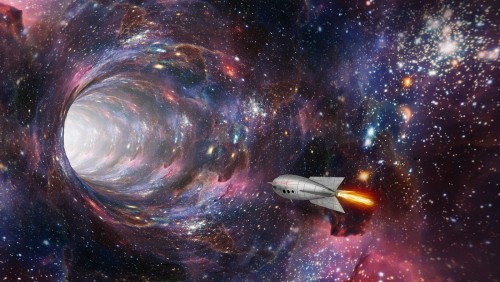But supposing they could and did exist, how would we even begin to go about finding them? According to a new research paper, all you need is a black hole, stars orbiting it, and equipment for predicting and measuring those orbits.
Wormholes are thought to work a bit like a fold in space-time - if you've read Madeleine L'Engle's A Wrinkle in Time, you'll be familiar with the analogy. Think of an ant walking across a piece of fabric from one point to another. If the fabric is flat, the ant has to travel the maximum distance. However, if you fold the fabric so the two points almost touch, all the ant has to do is jump from one section to the other.
Now imagine the fabric is space-time, and a tunnel in the space between the two points is the wormhole. Physicists Albert Einstein and Nathan Rosen published an influential paper on this concept in 1935, so it's also known as an Einstein-Rosen bridge.
According to the new paper by scientists at the University at Buffalo and Yangzhou University, there may be a really simple way to detect such wormholes. They argue that because the tunnel brings two regions of space closer together, massive objects - such as stars - on the other end of the wormhole would gravitationally affect the motion of things on 'our' end of the tunnel.
One of the things that would be required for the hypothetical formation of a wormhole is a gravitationally extreme environment, such as the space around a black hole (or even inside the event horizon of a black hole).
So, to observe this effect, you'd need a black hole and one or more stars in orbit around it.
In the Milky Way, we have just such a region - the galactic centre. The supermassive black hole therein, Sagittarius A*, is orbited by a whole bunch of stars, which as it turns out is really useful for things like testing relativity.
If there's a wormhole in the region, we should be able to detect it based on how these stars move.
"If you have two stars, one on each side of the wormhole, the star on our side should feel the gravitational influence of the star that's on the other side. The gravitational flux will go through the wormhole," says cosmologist Dejan Stojkovic of the University at Buffalo.
"So if you map the expected orbit of a star around Sagittarius A*, you should see deviations from that orbit if there is a wormhole there with a star on the other side."
It wouldn't be easy. Sagittarius A* has a mass 4 million times that of the Sun - it is by far and away the dominant gravitational force in the region. Separating out the effect of one or even a handful of stars would be painstaking work.
And if the wormhole was actually inside the black hole's event horizon, as some theorists predict, all bets would be off - the gravitational influence of the star coming through the wormhole would be indistinguishable from the gravitational influence of the black hole.
But we do have datasets astronomers can use to test this. Those tests of relativity mentioned earlier were based on a star named S0-2, or S2. Two separate teams took observations of S2 for over 25 years. And our instruments are becoming more and more sophisticated and precise - which means the precision required to make the described detection is not out of reach.
Even if we did detect a disturbance in the star's orbit, that wouldn't be conclusive. More evidence would be needed. But if we do want to find wormholes, we're going to need a starting point, and this new paper describes just that.
That said, even if wormholes did exist, it's unlikely they'd provide us with a neat travel mode.
"Even if a wormhole is traversable, people and spaceships most likely aren
't going to be passing through," Stojkovic said.
"Realistically, you would need a source of negative energy to keep the wormhole open, and we don't know how to do that. To create a huge wormhole that's stable, you need some magic."

It's a lovely thought - a tunnel connecting two regions of space-time, a sort of cosmic shortcut. Such wormholes are mostly thought to belong in the realm of science fiction, since if one happened to actually form in our Universe, physics dictates it would be unstable and collapse immediately.




